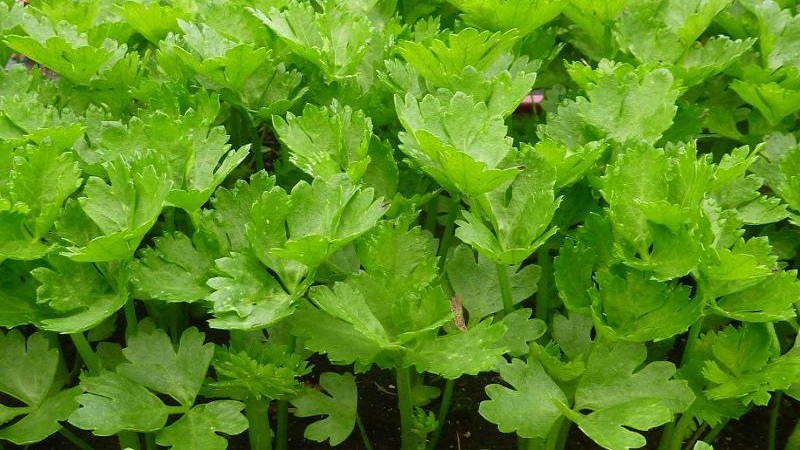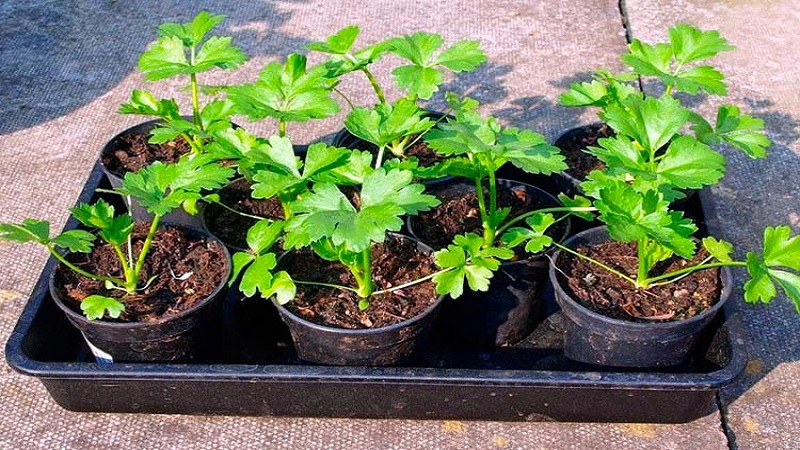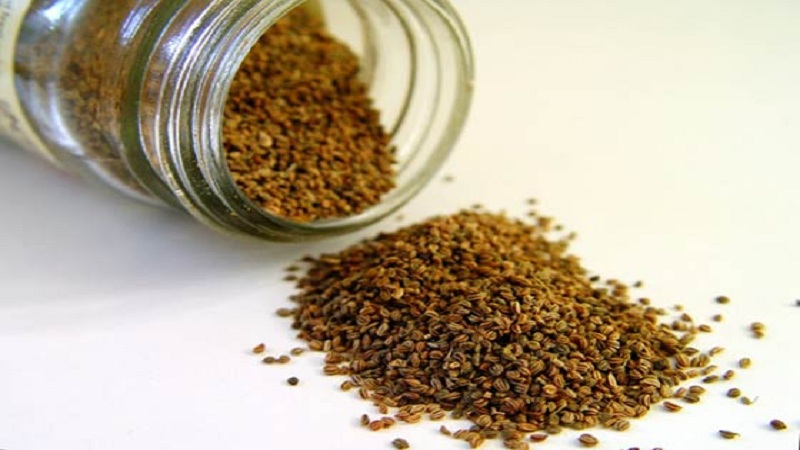How to Grow and Where to Apply Leafy Celery
Leafy celery is a type of vegetable. Greens are very popular among the residents of our country. It is used to flavor dishes, is included in the menu for weight loss, and is used to prepare folk remedies.
The plant has a unique set of vitamins and minerals, can replace salt in food, remove toxins and radionuclides. In this article, we'll show you how to grow and use leafy celery in a variety of ways.
The content of the article
Description of leaf celery
Leaf celery is a biennial vegetable from the Umbelliferae family. In the first year of cultivation, it forms a rosette of glossy leaves of a dark green hue. In the second year after sowing, a straight stem 30-100 cm high and an inflorescence appear. The culture enters the flowering period in the second decade of July, and in early August the seeds ripen. After that, the plant dies.
Leaf celery does not grow thick petioles and large root vegetables like other varieties. It is used fresh for flavoring salads, soups, meat dishes.
The openwork celery leaves resemble parsley, but have a completely different, pronounced spicy aroma.
In the photo - leafy celery.

Why leafy celery is good
Leafy celery is rich in vitamins and minerals. It is included in the menu for weight loss, dietary nutrition for gastritis, gastric ulcer and duodenal ulcer, urolithiasis. We will tell you more about the beneficial properties of the plant below.
Chemical composition, nutritional value and useful properties
The table shows the vitamin and mineral composition of leaf celery (per 100 g of product).
| Substance | Content | Norm |
| Vitamin A | 750 mcg | 900 mcg |
| Beta carotene | 4.5 mg | 5 mg |
| Vitamin B1 | 0.02 mg | 1.5 mg |
| Vitamin B2 | 0.1 mg | 1.8 mg |
| Vitamin B4 | 6.1 mg | 500 mg |
| Vitamin B5 | 0.246 mg | 5 mg |
| Vitamin B6 | 0.08 mg | 2 mg |
| Vitamin B9 | 21 μg | 400 mcg |
| Vitamin C | 38 mg | 90 mg |
| Vitamin E | 0.5 mg | 15 mg |
| Vitamin H | 0.65 μg | 50 mcg |
| Vitamin K | 29.3 mcg | 120 mcg |
| Vitamin PP | 0.5 mg | 20 mg |
| Potassium | 430 mg | 2500 mg |
| Calcium | 72 mg | 1000 mg |
| Silicon | 2.9 mg | 30 mg |
| Magnesium | 50 mg | 400 mg |
| Sodium | 200 mg | 1300 mg |
| Sulfur | 6.9 mg | 1000 mg |
| Phosphorus | 77 mg | 800 mg |
| Chlorine | 26.8 mg | 2300 mg |
| Iron | 1,3 mg | 18 mg |
| Iodine | 7.5 mcg | 150 mcg |
| Cobalt | 0.86 mcg | 10 mcg |
| Manganese | 0.103 mg | 2 mg |
| Copper | 35 mcg | 1000 mcg |
| Molybdenum | 5.4 μg | 70 mcg |
| Selenium | 0.4 μg | 55 mcg |
| Fluorine | 4 μg | 4000 mcg |
| Chromium | 2.1 μg | 50 mcg |
| Zinc | 0.13 mg | 12 mg |
The nutritional value:
- calorie content - 12 kcal;
- proteins - 0.9 g;
- fats - 0.1 g;
- carbohydrates - 2.1 g.
Benefit and harm
Useful properties of leaf celery:
- removal of inflammation;
- protection of cells from the negative effects of oxidative processes;
- prevention of cancer development;
- elimination of toxins, radionuclides, nicotine;
- immunity support;
- acceleration of the breakdown of fats, proteins and carbohydrates;
- increased sex drive;
- strengthening of blood vessels;
- normalization of blood pressure;
- lowering the level of bad cholesterol;
- increased hemoglobin;
- elimination of allergy signs;
- laxative effect;
- general toning of the body;
- removal of excess fluid from tissues;
- prevention of Alzheimer's disease;
- regulation of metabolism;
- rejuvenation of the body;
- reducing the level of carcinogens;
- regulation of the menstrual cycle;
- reduction of unpleasant manifestations of menopause.
Celery leaf is not recommended for pregnant women due to the risk of contraction of uterine smooth muscles. Breastfeeding it is worth postponing the use of the product, since it changes the taste of milk.
Greens are contraindicated for people suffering from gastritis with high acidity and urolithiasis (with large kidney stones).
Agrotechnics of culture
Early leaf celery varieties are grown by direct sowing near the ground. Late varieties have a long growing season and require pre-sowing seed for seedlings.
Preparing seeds and soil for seedlings
The growing season for leaf celery is 50-100 days, depending on the variety. Sowing seeds for seedlings in the northern regions is carried out in the second decade of March. Residents of the middle zone begin sowing in early April. In the south of the country, the leafy variety is sown directly into the ground in April due to favorable weather conditions.
The celery seed is protected by a dense shell containing a large amount of essential oils. Therefore, the seeds have a low germination rate.
To speed up the awakening process, planting material:
- soaked in warm water for a week;
- wrapped in a damp cloth or gauze for 2-3 days;
- put in a cloth bag and pour 2-3 times with water heated to 50 ° C;
- germinate in wet sawdust;
- the material is subjected to stratification: put in a damp cloth and left at room temperature for a week, then placed in a refrigerator for two weeks.
After all procedures, the seed is dried.
Reference. Pre-preparation speeds up the emergence of seedlings. Seedlings appear in 1-2 weeks.
To grow seedlings of leafy celery, use a ready-made substrate or make a soil mixture yourself from:
- turf, sand, peat, sawdust (1: 1: 1: 1);
- peat, vermiculite, humus (3: 1: 1);
- peat, humus, wood ash (3: 1: 1);
- biohumus and sand (1: 1).
The soil is disinfected in an oven, microwave oven, double boiler, spilled with a dark solution of potassium permanganate, "Baikal-M", "Shining".
For every 10 kg of soil mixture add 200 g of wood ash and 20 g of urea.
Containers for seedlings are washed and treated with Fitosporin or copper sulfate.
Sowing instructions
The prepared containers are filled with soil and the seeds are spread with an interval of 2 cm. A layer of earth is poured on top and poured with clean water through a sieve.
Until the emergence of shoots, the container is kept in a dark room at a temperature of + 20 ... + 22 ° C, then taken out on a sunny windowsill.
As soon as the leaves hatch, the air temperature in the room is reduced to + 12 ... + 16 ° С, and after 10 days it is raised to + 20 ... + 25 ° С.
Seedlings with 3-5 leaves dive into separate glasses, choosing the strongest specimens and shortening the central root to quickly build up green mass.
Reference. The norm of daylight hours for leaf celery is 16 hours. The optimum air temperature is + 18 ... + 20 ° С.
Seedlings are fed with chicken manure and Nitrofoskoy, alternating fertilizers.
For direct sowing of seeds in open ground, the site begins to be prepared in the fall: deep plowing is carried out and fertilized with humus. In the spring, the land is plowed again, loosened and the beds are spilled with a solution of potassium permanganate or copper sulfate.
Sowing seeds is carried out after warming up the soil to + 10 ° C. In the southern regions this happens in April. Depressions are made in the soil no more than 1 cm and seeds are sealed at a distance of 2-3 cm.
Seedlings are transferred to open ground in early May. Furrows are formed at a depth of 25-30 cm at a distance of 40 cm. The row spacing is 50 cm. Wood ash is placed on the bottom, a layer of earth is poured on top.
Saplings are planted together with an earthen clod. Further, the beds are mulched with sawdust or straw to retain moisture in the soil and reduce the amount of weeds.
Landing is performed on a cloudy day. If there is a threat of night frosts, the seedlings are covered with black agrofibre.
Care
Leaf celery is a moisture-loving plant, but it tolerates short-term drought. Watering is done 1-2 times a week.
For a set of greens, plants are fertilized with organic matter and minerals. This is especially important when growing crops on poor soil.
The first top dressing is applied 14 days after planting the seedlings - 40 g of "Nitrofoski" per 10 liters of water. Two weeks after the first feeding, add mullein infusion in a ratio of 1:10.
After 30 days, fertilize with a complex feeding "Kemira Hydro" - 10 g per 10 liters of water.
Further, celery is fertilized with organic matter every 14 days with an infusion of chicken manure, mullein, nettle.

Disease and pest control
Leaf celery has a strong immune system and rarely gets sick in the open field. Sometimes infection with fungi and viruses occurs. Pathogenic microflora inhibits plant growth and deprives the gardener of the opportunity to harvest a full harvest.
The table describes celery fungal diseases and how to deal with them.
| Disease | Signs | Treatment | Prevention measures |
| Powdery mildew | White bloom on both sides of the leaves | Treatment of plants with "Fundazol" or "Topsin-M" 20 days before cutting the greens |
|
| Septoriasis | Colorless spots with dark edging, leaf curling, plant drying
|
Treatment of plants with "Fundazol" or "Topsin-M" 20 days before cutting the greens | |
| Fomoz | Thinning of petioles at the base, yellowing of leaves | Treatment of plants with "Fundazol" or "Topsin-M" 20 days before cutting the greens |
Cucumber mosaic is the most dangerous viral disease of the leaf variety that does not respond to treatment. Infestation is indicated by a slowdown in plant growth and raised rings on the leaves. The affected celery is immediately removed from the site. For the prevention of viral mosaics, they are fighting aphids and ticks.
Celery planting in the open field affects the celery fly, aphids, carrot flies, spider mites. Pests destroy the leaves, suck the juice from the stems, weakening the plant. To successfully combat them, biological insecticides "Fitoverm", "Iskra-Bio" are used. Greens after processing can to eat after two days.
For natural protection, the beds are sown with onions and garlic. These crops scare off many insects with their aroma.
Folk methods of struggle:
- 1 tbsp. l. apple cider vinegar in 1 liter of water;
- decoction of onion peels (100 g per 2 liters of water);
- kefir and milk whey (1 liter per 1 liter of water);
- dusting with red or black ground pepper.
Harvesting and storage
Celery leaves are cut 2-3 times over the summer with an interval of 35-40 days. The last harvest is carried out before the onset of frost, in late September - early October.
In the process of cutting the leaves, petioles up to 5 cm long are left. This allows you to maintain a weak central rosette, which will grow again and save the root system from decay in winter.
Leaf celery is preserved for the winter by drying, freezing and salting. Even in this form, it does not lose its beneficial properties and aroma.
Application of leaf celery
Leaf celery is widely used in cooking and traditional medicine. Low calorie content and the ability to remove excess fluid from the body make it an irreplaceable assistant in the process of losing weight.
In cooking

Celery leaves are used as a fragrant spice. Greens are added to salads, side dishes of vegetables and cereals, soups, broths, and used to decorate dishes.
Green salad with nuts
Juicy, refreshing and moderately spicy salad will appeal to lovers of light, low-calorie dishes.
Ingredients:
- lettuce leaves - 500 g;
- green onions - 100 g;
- celery leaves - 1 bunch;
- celery stalks - 2 pcs.;
- parsley, dill - to taste;
- pine nuts (walnuts) - 50 g;
- pitted green olives - 8-10 pcs .;
- olive oil - 2 tablespoons l .;
- lemon juice - 1 tbsp l .;
- Dijon mustard - 1 tsp;
- honey - 1 tsp;
- salt, pepper - to taste.
Preparation:
- Wash lettuce and greens, dry on a paper or waffle towel. Tear the salad with your hands, chop the herbs with a knife.
- Finely chop the olives.
- Dry the nuts in a dry frying pan.
- Mix oil, lemon juice, mustard, honey, salt and pepper and season the salad.
Tuna salad
This salad saturates perfectly, has a light spicy aftertaste and aroma.
Ingredients:
- tuna in olive oil - 125 g;
- celery greens - 1 bunch;
- champignons - 100 g;
- Tabasco sauce - 1 tsp;
- Dijon mustard - 1 tsp;
- salt, pepper - to taste;
- lemon juice - 1 tbsp l.
Preparation:
- Open a can of tuna, drain the oil into a bowl, and chop the fish with a fork.
- Wash the mushrooms, dry, bake in the oven for 5-10 minutes, cut into pieces.
- Rinse the celery greens under the tap and dry.
- In a bowl, mix canned oil, lemon juice, mustard, tabasco with salt and pepper, season the salad.
In folk medicine
In traditional medicine, celery root is mainly used. Its freshly squeezed juice is recommended for gastritis, stomach ulcers, liver dysfunctions, flatulence.
Greens help with gout and rheumatism. The leaves and finely chopped root are put into a thermos, poured with boiling water and insisted for 3-5 hours. The infusion is used for rubbing sore spots and compresses.
Dried herb tea is an excellent diuretic. It dissolves salt in the body, treats colds, calms the nervous system. For its preparation 2 tbsp. l. 500 ml of boiling water is poured over dry leaves and brought to a boil over low heat. Take no more than two glasses of tea a day.
Ointment from stems and leaves heals purulent wounds, rashes, ulcers, urticaria, lichen, eczema. Fresh petioles together with leaves are passed through a meat grinder and mixed in equal proportions with ghee. The product is applied to the affected areas and covered with clean gauze. A jar of ointment is stored in the refrigerator.
Slimming
With the aim of slimming use fresh petioles and greens. The products are put in a blender and chopped thoroughly. The drink is drunk neat or mixed with apple, carrot, orange juice.
Nutritionists recommend including fresh celery in the daily diet of obese people.
Celery dishes are suitable for a short-term diet of three days.
Council. Instead of the usual fried soup in vegetable oil, prepare a dietary Bonn soup based on white cabbage, tomatoes, onions, bell peppers, celery and parsley.
Conclusion
Leaf celery, a type of vegetable from the Umbrella family, is grown primarily through seedlings similar to root and petiole celery. Early varieties are subject to direct sowing in the soil in the south of the country. Planting care provides for timely watering, mulching (instead of frequent loosening and weeding), fertilization with organic matter and minerals.
Fragrant greens are used in cooking to flavor dishes, traditional medicine to treat skin, gout, and urolithiasis. It will be included in the menu for slow but steady weight loss.